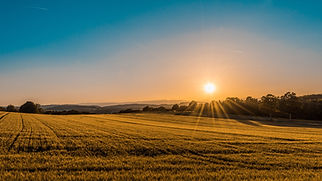OUR history
Who were the Bible Christians?
The chapels in the Ringsash Circuit were built by a small Methodist denomination ‐ the Bible Christians. They began in North West Devon and North Cornwall in 1815 and their strength was always in the South West. Most of their early chapels were in rural areas and up to the 1830's a large number of preaching places were opened in North Devon. Most were not purpose‐built chapels but farm houses, cottages and even mills. Although a tiny, poor denomination, the Bible Christians modelled their organisation on the mighty Wesleyan Church and in 1819 they divided their scattered places into circuits (groups of chapels that were cared for by one or more ministers). Ringsash was one of these earliest circuits. This name needs explaining! One of the places in their circuit was "Ashreigney" but they turned its name round to become "Ringsash". (They did the same in West Somerset and their chapel in "Brompton Regis", was called “Kingsbrompton".)
Within a few years new places were opened and by 1824 the Ringsash circuit had 15 places and in another ten years this grew to 31, including Bishops Tawton, South Molton, Rackenford, Hittisleigh. In 1838 it was divided into Upper and Lower Parts and as other circuits were formed and established themselves, chapels were taken away from Ringsash. BUT since 1819 there has been a Ringsash Circuit and it has never included anything but chapels in the Bible Christian tradition. The most recent change was in 2010 when several chapels joined the South Molton Circuit, leaving Ringsash with just five chapels. Ironically Ashreigney was not one of the five.
In 1907 the Bible Christians joined two other small Methodist denominations to form the "United Methodist Church". Then in 1932 the United Methodists joined the Wesleyans and Primitive Methodists to form the modern "Methodist Church of Great Britain". In 1907 Ringsash contained 13 chapels and each had a Biblical name ‐ a long‐standing Bible Christian tradition. Witheridge chapel came to Ringsash from the former Tiverton Circuit in the early 1970’s but without a Biblical name!
Our Churches
"Ebenezer" Chapel, Copplestone (OS SS 770 026)
This flourishing chapel was at the edge of three parishes until Copplestone became a civil parish in 1992. The present building was in Down St. Mary, its cemetery in Colebrooke and the former chapel of 1831 across the road was in Crediton! The chapel's old name, "Ebenezer" comes from the Old Testament, Samuel 7.12.
There was Methodist preaching here from 1819 in a cottage and this later moved to Elston Farm until a first chapel was built about 1831, the same year that the road to Barnstaple became a turnpike. Eventually more room was needed and in 1888 the present chapel was built across the road and the old one then was used for the Sunday School. The present community room behind church was built in 1981 and the old chapel sold.
"Emmanuel" Chapel, Morchard Bishop (OS SS 768 077)
Morchard is a large village on the old turnpike road but its prosperity suffered when the new turnpike was built in the valley in the 1820's! In Fore Street is a row of thatched cottages, said to be the longest in Britain.
Bible Christian preachers first came to the village in 1819 and a small congregation was gathered. This grew so that in 1846 a chapel was built, which is still in use today. A local man, James Way, became a Bible Christian minister in 1826 and in 1850 he sailed to Australia, where many Bible Christians from the South West had already emigrated. His son Samuel, who was educated at Shebbear College in Devon, became a lawyer and eventually rose to be Sir Samuel Way, Chief Justice of South Australia. The Bible Christians copied the annual Conference of the Wesleyans, but on a much smaller scale and in 1854 it was held in the Morchard chapel, causing some local excitement. The adjacent Sunday school was built in 1928.
"Providence" or "Hele Lane" Chapel
The Old Chapel at Hele Lane in Thelbridge Parish (OS SS 794 108)
In 1858 a body of Bible Christians bought a privately owned chapel, schoolroom, cottage and burying ground at Hele Lane for £2, which then was vested in trustees. Although cheap, this building caused expense later as one of the walls collapsed and had to be rebuilt in the 1920’s.
The New Chapel at Black Dog in Washford Pyne Parish (OS SS 806 098)
In the 1950's the congregation was not large but the building was old. When the council school at Black Dog was closed and offered for sale in 1955, the congregation agonised about buying it. They decided against and the school was duly sold. BUT it came back on the market quickly and this was regarded as prophetic so it was bought and opened as a chapel in 1956 and is in use today. The new chapel, between Tiverton and Morchard Bishop is about a mile from Hele Lane but has kept the familiar name.
After the move the old chapel was demolished to enlarge the burying ground which is still in use.
Chapel, Witheridge (OS SS 804 145)
Witheridge is a large ancient village between Tiverton and South Molton. Bible Christian services were being held here in 1819 in a succession of houses until the first permanent chapel was acquired, by converting a cob and thatch barn in 1855. This was on the site of the present school room. A Sunday school was started and a new chapel was soon needed. So two cottages beside the chapel were bought and the present chapel was built, opening in 1859. The preacher at the opening was F. W. Bourne, the author of "Billy Bray, the King's Son" – the Bible Christian best‐seller. Then in 1903 the present school room was built.
by Roger Thorne
